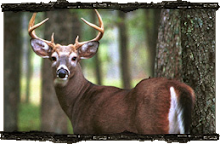In Photo One, "these brush piles were built to protect rabbits. While the rabbits can fit in the smallest spaces at and near the bottom, their larger predators, such as coyotes, cannot fit between the base logs. As the smaller brush at the t op decomposes, we will replenish it to prolong the useful lifespan of each 'bunny bolt hole.' There are three similar brush piles in a two-acre section of timber stand that has been thinned, or improved under the Program."

Next, in photos two and three


"The snag trees were created to provide habitat for woodpeckers and other wildlife. (Note the cut-mark below the W showing the girdling by a chainsaw). How the feds taught them to read the 'W' is a subject for another blog. There are four such wildlife trees in the same two-acre section. Each tree has been girdled with a chain saw so it will die standing, becoming a potential home for woodpeckers.
Our wood lot was part of the approved clear cut at the time of the spruce bud worm infestation about 30 years ago. When my husband and I bought it, it was clear to our untrained eyes that it needed some help. We have not stopped asking questions since then. Our sources have included neighbors, foresters, arborists and others who do the tree work. Other valuable resources has been the Small Woodlot Owners Association of Maine (SWOAM), officials for the WoodsWise Program, and the NRCS personnel out of Farmington 778-4767. We are both artists, pleased to be full time residents of Rangeley since 2009. You can see a sampling of our art work at www. ebbyjake.com"
Thank you Jaine for your contribution!
Like Jaine and George, please contact NRCS via internet or join SWOAM if you are interested in developing your property.
If you have a dead tree out back that is at least 3 feet thick and 6 feet high, LEAVE IT ALONE! Many amphibians, reptiles and mammals use cavities for nesting as well. At least 35 bird species in the Northeast use these snags for food and help to control unwanted insect pests. The more woodpeckers and birds, the better for our insect control. Also, decomposing logs on your property provide a source of food and lodging for critters.

No comments:
Post a Comment